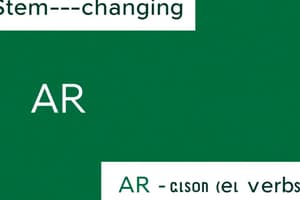Podcast
Questions and Answers
Which verb is used for conveying more temporary states, conditions, or locations in Spanish?
Which verb is used for conveying more temporary states, conditions, or locations in Spanish?
- Ser
- Estar (correct)
- Haber
- Tener
In the present tense, what is the correct conjugation of 'estar' for 'I am'?
In the present tense, what is the correct conjugation of 'estar' for 'I am'?
- Yo era
- Yo estoy (correct)
- Yo soy
- Yo fui
Which verb is used for more permanent or inherent qualities in Spanish?
Which verb is used for more permanent or inherent qualities in Spanish?
- Estar
- Haber
- Ser (correct)
- Tener
In which situations would 'estar' be used?
In which situations would 'estar' be used?
'El libro está en la mesa.' translates to:
'El libro está en la mesa.' translates to:
Flashcards are hidden until you start studying
Study Notes
Spanish Verb Conjugation
- The verb 'estar' is used for conveying more temporary states, conditions, or locations in Spanish.
'Estar' Conjugation
- In the present tense, the correct conjugation of 'estar' for 'I am' is 'estoy'.
Permanent vs. Temporary Qualities
- The verb 'ser' is used for more permanent or inherent qualities in Spanish.
When to Use 'Estar'
- 'Estar' is used in situations where the state or condition is temporary or changing, such as:
- Emotions or feelings
- Physical or mental states
- Location
Example Sentence
- 'El libro está en la mesa.' translates to 'The book is on the table.'
Studying That Suits You
Use AI to generate personalized quizzes and flashcards to suit your learning preferences.



